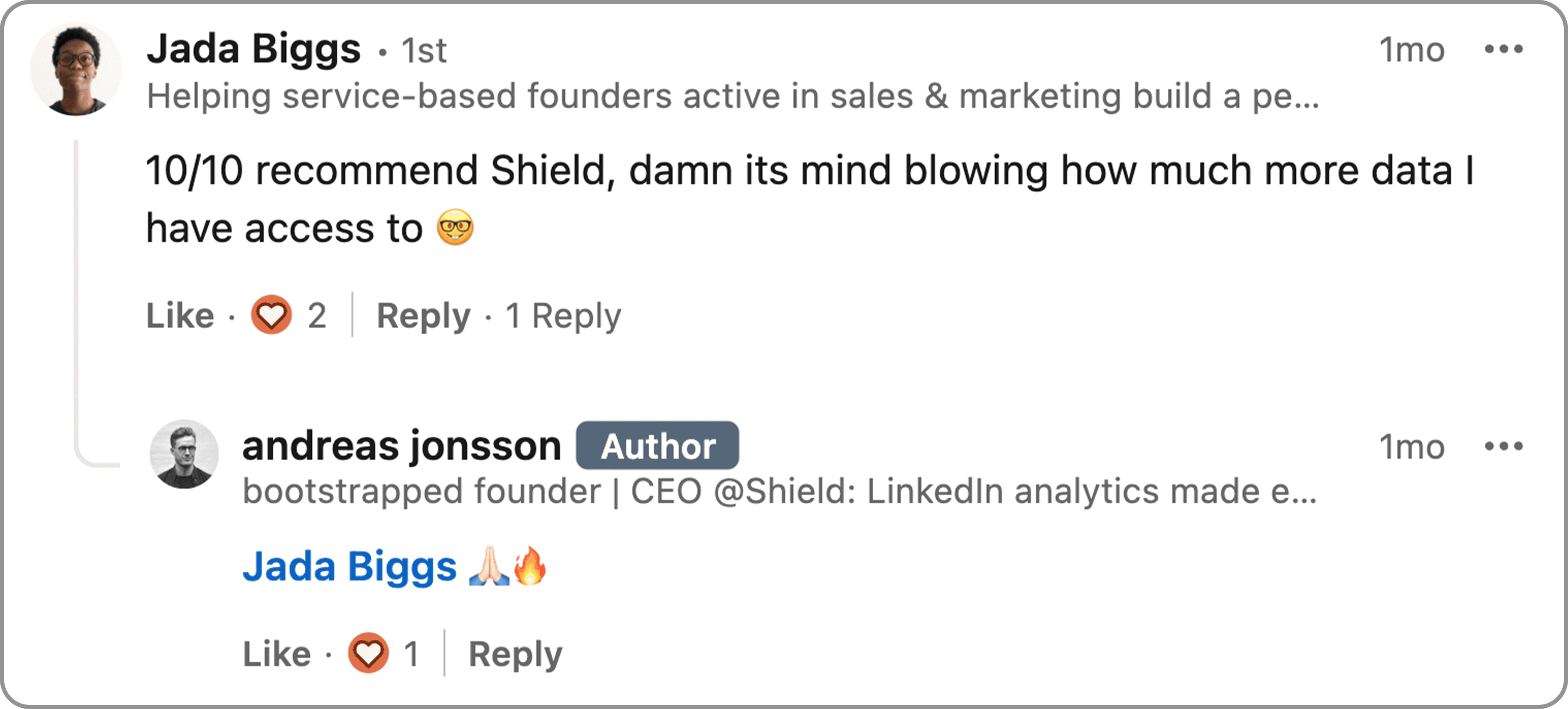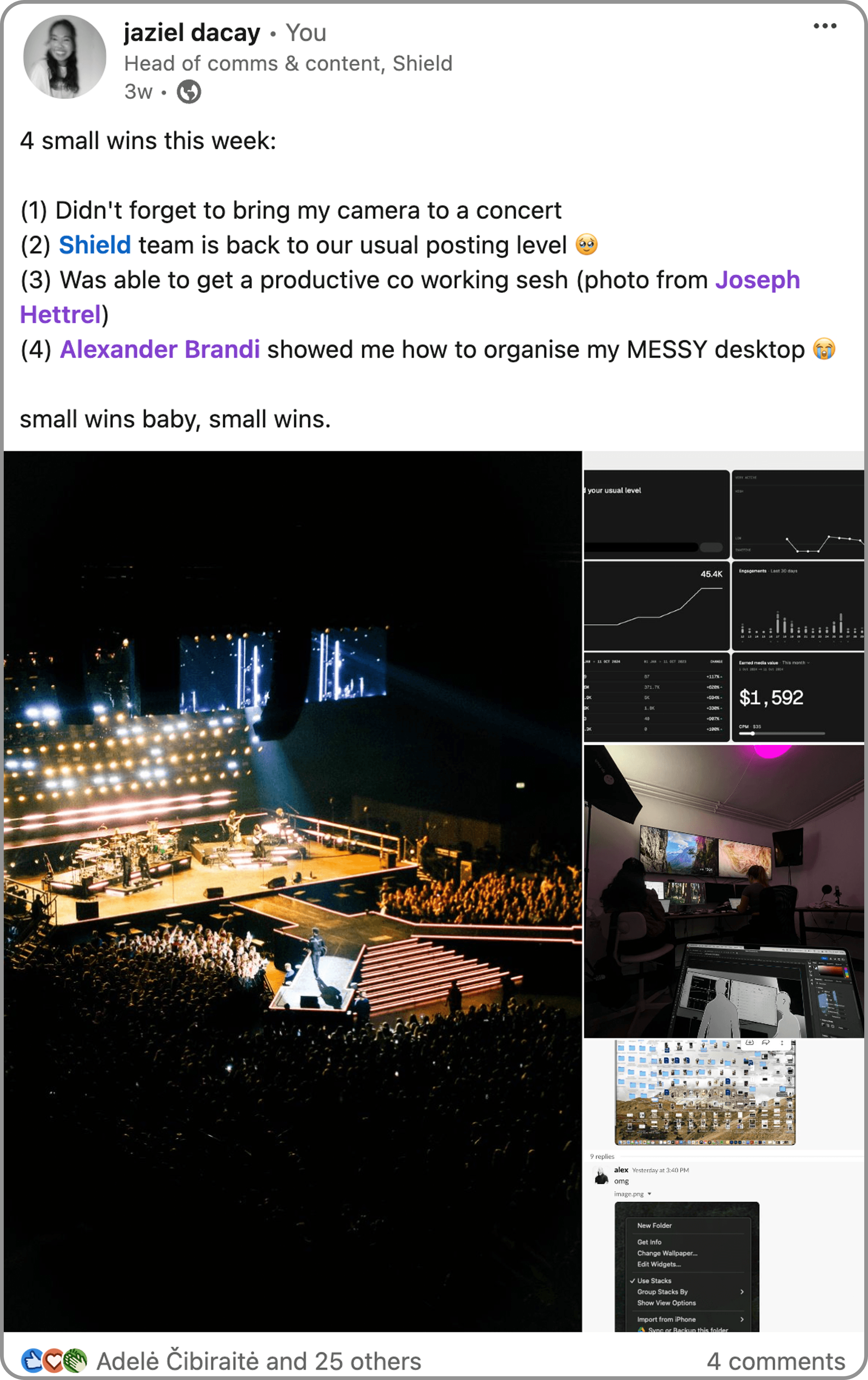What is employee advocacy and why does it matter?




What is employee advocacy?
Employee advocacy is becoming an invaluable tool in the corporate communications playbook for companies aiming to amplify their reach and build credibility in their markets. By empowering employees to create and share content about their workplace, businesses can extend their brand messages far beyond traditional corporate channels and tap into the authentic voices of their workforce. Their employees.
Understanding employee advocacy
Employee advocacy is when employees voluntarily create and share content related to their company on their personal social media profiles, usually on platforms like LinkedIn. This content might include posts about company news, insights into industry trends, or even personal anecdotes about their workplace experiences. Preferably not only reposts from the company blog, but rather injecting their own personality into the content making it more authentic, humanizing the company brand in the process. At its core, employee advocacy leverages employees’ personal networks to reach new audiences in a more genuine and relatable way than typical brand marketing.
Here's an example from our CEO:

Why does employee advocacy matter?
Employee advocacy isn’t just another marketing trend—it’s a powerful strategy for building trust, boosting brand visibility, and engaging employees. Here’s why it matters:
Increased brand visibility
When employees create and share content with their networks, they also introduce the company brand to a wider audience. Each post has the potential to reach hundreds or thousands of new eyes, making it easier for businesses to grow their digital presence organically. Think about the number of employees in your organization and the potential impact. This expanded reach is invaluable for general brand awareness, especially for companies focusing on digital engagement (which, to be honest, should be most companies in this time and age).

Statistics from shieldapp.ai
Building trust and credibility
People trust recommendations and insights from individuals far more than they do traditional ads or corporate communications. When employees advocate for their company, they act as brand ambassadors, lending authenticity to the company’s message. Potential customers and clients are more likely to engage with and trust a brand that is positively endorsed by its own team.

Positive impact on employee engagement and loyalty
Employee advocacy programs can positively impact workplace culture. By giving employees the freedom to create and share their work experiences and achievements, businesses can boost morale and strengthen loyalty. Employees who feel trusted and valued are more likely to appreciate and connect deeply with their roles, which benefits both them and the company.

Key benefits of employee advocacy
Employee advocacy offers tangible advantages for both businesses and employees. Here are some of the key benefits that make it an essential component of any modern brand strategy:
Expanding organic reach:
Unlike paid ads, employee-shared content is typically organic, meaning it reaches audiences without additional cost. The networks employees bring can be highly relevant to the brand, offering exposure to targeted audiences.

Earned media value on shieldapp.ai
Humanizing the brand:
Advocacy content from employees can include more personal, informal messages that resonate more deeply with audiences. This helps humanize the brand, giving it a relatable face and building meaningful connections with customers.
Personal branding for employees:
Participating in employee advocacy allows employees to build their own personal brands. By showcasing expertise and industry knowledge, employees position themselves as thought leaders, which can be beneficial for career growth while also enhancing the credibility of the company.
Driving engagement through authenticity:
Employee-shared content generally sees higher engagement because it feels more authentic and less “salesy” than traditional marketing materials. Audiences are more likely to engage with posts that come from real people. Especially on LinkedIn, authentic content is rewarded by the algorithms.
FAQ on Employee Advocacy
What is Employee Advocacy software?
Employee advocacy software helps businesses manage, track, and measure their employee advocacy efforts, particularly on platforms like LinkedIn. With this software, like Shield’s employee advocacy software, companies can empower their teams to learn what works, gain insights into post performance across personal LinkedIn profiles, and streamline engagement tracking—all from a single dashboard.
How do I set up an Employee Advocacy program?
Setting up an advocacy program involves defining clear goals, selecting initial employee advocates, curating shareable content (if employees are not already creating their own), and using tools like Shield to track performance. By setting a structure and providing resources, companies can make it easy for employees to create and share relevant and impactful content.
How can I track my Employee Advocacy efforts?
The key to effective employee advocacy is measurement. With Employee Advocacy analytics tools like Shield, businesses can track metrics such as post impressions, engagement, and follower growth, across as many personal profiles as required. This data helps companies refine their strategy, learn what works, all while ensuring that the program continues to generate value over time.
Conclusion
Employee advocacy is a powerful, long-term strategy for amplifying brand reach, building credibility, and engaging employees. By encouraging and empowering employees to share authentic content, companies can expand their reach in a cost-effective way while strengthening workplace culture and building real relationships in their markets.
Ready to get started? Consider implementing an employee advocacy tool like Shield to simplify and optimize your advocacy efforts. With the right software, you can transform your team into brand ambassadors and see measurable results from LinkedIn and beyond.
___
What is employee advocacy?
Employee advocacy is becoming an invaluable tool in the corporate communications playbook for companies aiming to amplify their reach and build credibility in their markets. By empowering employees to create and share content about their workplace, businesses can extend their brand messages far beyond traditional corporate channels and tap into the authentic voices of their workforce. Their employees.
Understanding employee advocacy
Employee advocacy is when employees voluntarily create and share content related to their company on their personal social media profiles, usually on platforms like LinkedIn. This content might include posts about company news, insights into industry trends, or even personal anecdotes about their workplace experiences. Preferably not only reposts from the company blog, but rather injecting their own personality into the content making it more authentic, humanizing the company brand in the process. At its core, employee advocacy leverages employees’ personal networks to reach new audiences in a more genuine and relatable way than typical brand marketing.
Here's an example from our CEO:

Why does employee advocacy matter?
Employee advocacy isn’t just another marketing trend—it’s a powerful strategy for building trust, boosting brand visibility, and engaging employees. Here’s why it matters:
Increased brand visibility
When employees create and share content with their networks, they also introduce the company brand to a wider audience. Each post has the potential to reach hundreds or thousands of new eyes, making it easier for businesses to grow their digital presence organically. Think about the number of employees in your organization and the potential impact. This expanded reach is invaluable for general brand awareness, especially for companies focusing on digital engagement (which, to be honest, should be most companies in this time and age).

Statistics from shieldapp.ai
Building trust and credibility
People trust recommendations and insights from individuals far more than they do traditional ads or corporate communications. When employees advocate for their company, they act as brand ambassadors, lending authenticity to the company’s message. Potential customers and clients are more likely to engage with and trust a brand that is positively endorsed by its own team.

Positive impact on employee engagement and loyalty
Employee advocacy programs can positively impact workplace culture. By giving employees the freedom to create and share their work experiences and achievements, businesses can boost morale and strengthen loyalty. Employees who feel trusted and valued are more likely to appreciate and connect deeply with their roles, which benefits both them and the company.

Key benefits of employee advocacy
Employee advocacy offers tangible advantages for both businesses and employees. Here are some of the key benefits that make it an essential component of any modern brand strategy:
Expanding organic reach:
Unlike paid ads, employee-shared content is typically organic, meaning it reaches audiences without additional cost. The networks employees bring can be highly relevant to the brand, offering exposure to targeted audiences.

Earned media value on shieldapp.ai
Humanizing the brand:
Advocacy content from employees can include more personal, informal messages that resonate more deeply with audiences. This helps humanize the brand, giving it a relatable face and building meaningful connections with customers.
Personal branding for employees:
Participating in employee advocacy allows employees to build their own personal brands. By showcasing expertise and industry knowledge, employees position themselves as thought leaders, which can be beneficial for career growth while also enhancing the credibility of the company.
Driving engagement through authenticity:
Employee-shared content generally sees higher engagement because it feels more authentic and less “salesy” than traditional marketing materials. Audiences are more likely to engage with posts that come from real people. Especially on LinkedIn, authentic content is rewarded by the algorithms.
FAQ on Employee Advocacy
What is Employee Advocacy software?
Employee advocacy software helps businesses manage, track, and measure their employee advocacy efforts, particularly on platforms like LinkedIn. With this software, like Shield’s employee advocacy software, companies can empower their teams to learn what works, gain insights into post performance across personal LinkedIn profiles, and streamline engagement tracking—all from a single dashboard.
How do I set up an Employee Advocacy program?
Setting up an advocacy program involves defining clear goals, selecting initial employee advocates, curating shareable content (if employees are not already creating their own), and using tools like Shield to track performance. By setting a structure and providing resources, companies can make it easy for employees to create and share relevant and impactful content.
How can I track my Employee Advocacy efforts?
The key to effective employee advocacy is measurement. With Employee Advocacy analytics tools like Shield, businesses can track metrics such as post impressions, engagement, and follower growth, across as many personal profiles as required. This data helps companies refine their strategy, learn what works, all while ensuring that the program continues to generate value over time.
Conclusion
Employee advocacy is a powerful, long-term strategy for amplifying brand reach, building credibility, and engaging employees. By encouraging and empowering employees to share authentic content, companies can expand their reach in a cost-effective way while strengthening workplace culture and building real relationships in their markets.
Ready to get started? Consider implementing an employee advocacy tool like Shield to simplify and optimize your advocacy efforts. With the right software, you can transform your team into brand ambassadors and see measurable results from LinkedIn and beyond.
___
What is employee advocacy?
Employee advocacy is becoming an invaluable tool in the corporate communications playbook for companies aiming to amplify their reach and build credibility in their markets. By empowering employees to create and share content about their workplace, businesses can extend their brand messages far beyond traditional corporate channels and tap into the authentic voices of their workforce. Their employees.
Understanding employee advocacy
Employee advocacy is when employees voluntarily create and share content related to their company on their personal social media profiles, usually on platforms like LinkedIn. This content might include posts about company news, insights into industry trends, or even personal anecdotes about their workplace experiences. Preferably not only reposts from the company blog, but rather injecting their own personality into the content making it more authentic, humanizing the company brand in the process. At its core, employee advocacy leverages employees’ personal networks to reach new audiences in a more genuine and relatable way than typical brand marketing.
Here's an example from our CEO:

Why does employee advocacy matter?
Employee advocacy isn’t just another marketing trend—it’s a powerful strategy for building trust, boosting brand visibility, and engaging employees. Here’s why it matters:
Increased brand visibility
When employees create and share content with their networks, they also introduce the company brand to a wider audience. Each post has the potential to reach hundreds or thousands of new eyes, making it easier for businesses to grow their digital presence organically. Think about the number of employees in your organization and the potential impact. This expanded reach is invaluable for general brand awareness, especially for companies focusing on digital engagement (which, to be honest, should be most companies in this time and age).

Statistics from shieldapp.ai
Building trust and credibility
People trust recommendations and insights from individuals far more than they do traditional ads or corporate communications. When employees advocate for their company, they act as brand ambassadors, lending authenticity to the company’s message. Potential customers and clients are more likely to engage with and trust a brand that is positively endorsed by its own team.

Positive impact on employee engagement and loyalty
Employee advocacy programs can positively impact workplace culture. By giving employees the freedom to create and share their work experiences and achievements, businesses can boost morale and strengthen loyalty. Employees who feel trusted and valued are more likely to appreciate and connect deeply with their roles, which benefits both them and the company.

Key benefits of employee advocacy
Employee advocacy offers tangible advantages for both businesses and employees. Here are some of the key benefits that make it an essential component of any modern brand strategy:
Expanding organic reach:
Unlike paid ads, employee-shared content is typically organic, meaning it reaches audiences without additional cost. The networks employees bring can be highly relevant to the brand, offering exposure to targeted audiences.

Earned media value on shieldapp.ai
Humanizing the brand:
Advocacy content from employees can include more personal, informal messages that resonate more deeply with audiences. This helps humanize the brand, giving it a relatable face and building meaningful connections with customers.
Personal branding for employees:
Participating in employee advocacy allows employees to build their own personal brands. By showcasing expertise and industry knowledge, employees position themselves as thought leaders, which can be beneficial for career growth while also enhancing the credibility of the company.
Driving engagement through authenticity:
Employee-shared content generally sees higher engagement because it feels more authentic and less “salesy” than traditional marketing materials. Audiences are more likely to engage with posts that come from real people. Especially on LinkedIn, authentic content is rewarded by the algorithms.
FAQ on Employee Advocacy
What is Employee Advocacy software?
Employee advocacy software helps businesses manage, track, and measure their employee advocacy efforts, particularly on platforms like LinkedIn. With this software, like Shield’s employee advocacy software, companies can empower their teams to learn what works, gain insights into post performance across personal LinkedIn profiles, and streamline engagement tracking—all from a single dashboard.
How do I set up an Employee Advocacy program?
Setting up an advocacy program involves defining clear goals, selecting initial employee advocates, curating shareable content (if employees are not already creating their own), and using tools like Shield to track performance. By setting a structure and providing resources, companies can make it easy for employees to create and share relevant and impactful content.
How can I track my Employee Advocacy efforts?
The key to effective employee advocacy is measurement. With Employee Advocacy analytics tools like Shield, businesses can track metrics such as post impressions, engagement, and follower growth, across as many personal profiles as required. This data helps companies refine their strategy, learn what works, all while ensuring that the program continues to generate value over time.
Conclusion
Employee advocacy is a powerful, long-term strategy for amplifying brand reach, building credibility, and engaging employees. By encouraging and empowering employees to share authentic content, companies can expand their reach in a cost-effective way while strengthening workplace culture and building real relationships in their markets.
Ready to get started? Consider implementing an employee advocacy tool like Shield to simplify and optimize your advocacy efforts. With the right software, you can transform your team into brand ambassadors and see measurable results from LinkedIn and beyond.
___
What is employee advocacy?
Employee advocacy is becoming an invaluable tool in the corporate communications playbook for companies aiming to amplify their reach and build credibility in their markets. By empowering employees to create and share content about their workplace, businesses can extend their brand messages far beyond traditional corporate channels and tap into the authentic voices of their workforce. Their employees.
Understanding employee advocacy
Employee advocacy is when employees voluntarily create and share content related to their company on their personal social media profiles, usually on platforms like LinkedIn. This content might include posts about company news, insights into industry trends, or even personal anecdotes about their workplace experiences. Preferably not only reposts from the company blog, but rather injecting their own personality into the content making it more authentic, humanizing the company brand in the process. At its core, employee advocacy leverages employees’ personal networks to reach new audiences in a more genuine and relatable way than typical brand marketing.
Here's an example from our CEO:

Why does employee advocacy matter?
Employee advocacy isn’t just another marketing trend—it’s a powerful strategy for building trust, boosting brand visibility, and engaging employees. Here’s why it matters:
Increased brand visibility
When employees create and share content with their networks, they also introduce the company brand to a wider audience. Each post has the potential to reach hundreds or thousands of new eyes, making it easier for businesses to grow their digital presence organically. Think about the number of employees in your organization and the potential impact. This expanded reach is invaluable for general brand awareness, especially for companies focusing on digital engagement (which, to be honest, should be most companies in this time and age).

Statistics from shieldapp.ai
Building trust and credibility
People trust recommendations and insights from individuals far more than they do traditional ads or corporate communications. When employees advocate for their company, they act as brand ambassadors, lending authenticity to the company’s message. Potential customers and clients are more likely to engage with and trust a brand that is positively endorsed by its own team.

Positive impact on employee engagement and loyalty
Employee advocacy programs can positively impact workplace culture. By giving employees the freedom to create and share their work experiences and achievements, businesses can boost morale and strengthen loyalty. Employees who feel trusted and valued are more likely to appreciate and connect deeply with their roles, which benefits both them and the company.

Key benefits of employee advocacy
Employee advocacy offers tangible advantages for both businesses and employees. Here are some of the key benefits that make it an essential component of any modern brand strategy:
Expanding organic reach:
Unlike paid ads, employee-shared content is typically organic, meaning it reaches audiences without additional cost. The networks employees bring can be highly relevant to the brand, offering exposure to targeted audiences.

Earned media value on shieldapp.ai
Humanizing the brand:
Advocacy content from employees can include more personal, informal messages that resonate more deeply with audiences. This helps humanize the brand, giving it a relatable face and building meaningful connections with customers.
Personal branding for employees:
Participating in employee advocacy allows employees to build their own personal brands. By showcasing expertise and industry knowledge, employees position themselves as thought leaders, which can be beneficial for career growth while also enhancing the credibility of the company.
Driving engagement through authenticity:
Employee-shared content generally sees higher engagement because it feels more authentic and less “salesy” than traditional marketing materials. Audiences are more likely to engage with posts that come from real people. Especially on LinkedIn, authentic content is rewarded by the algorithms.
FAQ on Employee Advocacy
What is Employee Advocacy software?
Employee advocacy software helps businesses manage, track, and measure their employee advocacy efforts, particularly on platforms like LinkedIn. With this software, like Shield’s employee advocacy software, companies can empower their teams to learn what works, gain insights into post performance across personal LinkedIn profiles, and streamline engagement tracking—all from a single dashboard.
How do I set up an Employee Advocacy program?
Setting up an advocacy program involves defining clear goals, selecting initial employee advocates, curating shareable content (if employees are not already creating their own), and using tools like Shield to track performance. By setting a structure and providing resources, companies can make it easy for employees to create and share relevant and impactful content.
How can I track my Employee Advocacy efforts?
The key to effective employee advocacy is measurement. With Employee Advocacy analytics tools like Shield, businesses can track metrics such as post impressions, engagement, and follower growth, across as many personal profiles as required. This data helps companies refine their strategy, learn what works, all while ensuring that the program continues to generate value over time.
Conclusion
Employee advocacy is a powerful, long-term strategy for amplifying brand reach, building credibility, and engaging employees. By encouraging and empowering employees to share authentic content, companies can expand their reach in a cost-effective way while strengthening workplace culture and building real relationships in their markets.
Ready to get started? Consider implementing an employee advocacy tool like Shield to simplify and optimize your advocacy efforts. With the right software, you can transform your team into brand ambassadors and see measurable results from LinkedIn and beyond.
___
Also interesting
Also interesting
Also interesting
Your first year, half price - all annual plans
Your first year, half price - all annual plans


